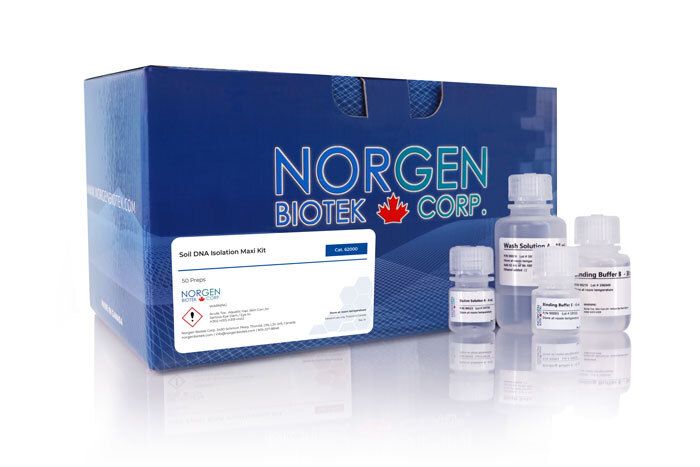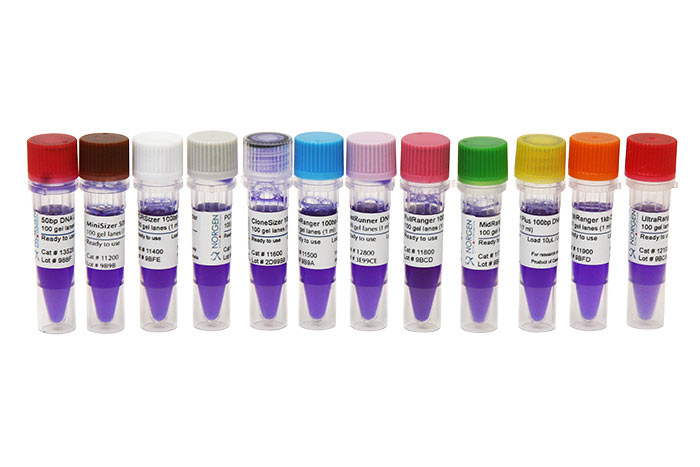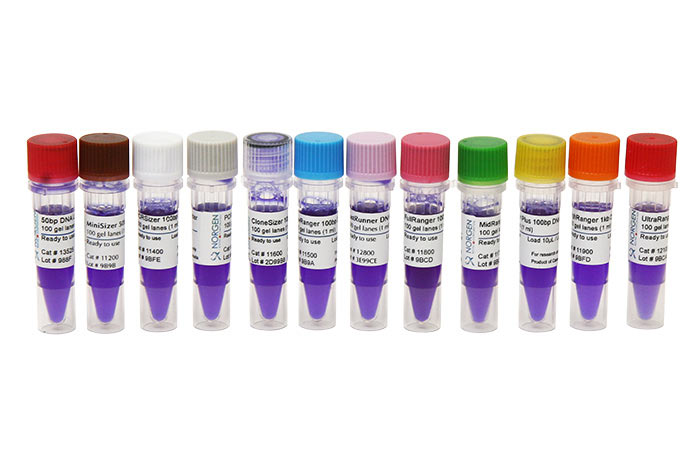Soil DNA Isolation Maxi Kit
For the detection of microorganisms from large soil samples

For research use only and NOT intended for in vitro diagnostics.
Soil DNA Isolation Maxi Kit
For the detection of microorganisms from large soil samples
Register today to receive an exclusive 15% off* on your first order.
Features and Benefits
- Rapid and convenient method to detect microorganisms in up to 10 g of soil samples
- Process all soil types
- Efficiently remove organic substances using the OSR Solution
- Remove all humic acid from DNA samples using the Maxi Humic Acid Removal Columns
- Fast and easy processing using a rapid spin-column format
- Isolate high quality total DNA from a variety of microorganisms including bacteria, fungi and algae
Norgen’s Soil DNA Isolation Maxi Kit provides a convenient and rapid method for the detection of microorganisms from large soil samples (up to 10 grams). All types of soil samples can be processed with this kit, including common soil samples and difficult soil samples with high humic acid content such as compost and manure. The kit removes all traces of humic acid using the provided Humic Acid Removal Column and the OSR (Organic Substance Removal) Solution. A simple and rapid spin column procedure is then used to further purify the DNA. Total genomic DNA can be isolated and purified from all the various microorganisms found in soil, such as bacteria, fungi and algae. The purified DNA is of the highest quality and is fully compatible with downstream PCR and NGS applications, as all humic acid substances and PCR inhibitors are removed during the isolation.
Details
Supporting Data
Figure 1. Resolution of DNA isolated from 10 g of two different soil types; regular soil (clay) and high humic acid soil (top soil) using Norgen’s Soil DNA Isolation Maxi Kit. For evaluation, 10 µL from the 1st elution (2 mL) and 2nd elution (2 mL) from each soil sample was run on 1X TAE 1.2% agarose gel. Excellent DNA integrity and yield were observed from the Soil DNA Isolation Maxi Kit. Marker = Norgen’s HighRanger DNA Ladder (Cat. 11900)
Figure 2. Difference in DNA yield between two soil types (clay and top soil) and elutions (1st and 2nd elution). Ten grams of soil was processed using Norgen’s Soil DNA Isolation Maxi Kit. The second elution increased the total DNA yield by an additional 20-30%.
Figure 3. High soil DNA quality was confirmed by real-time PCR using 8 µL of soil DNA (total PCR reaction volume was 20 µL) isolated using Norgen’s Soil DNA Isolation Maxi Kit to detect 16s rDNA. The 16s rRNA gene was successfully amplified in both the first elution (red) and second elution (blue) from two soil types (Clay = circle, Top soil = diamond) without PCR inhibition, indicating the excellent soil DNA quality from 10 grams of soil.
|
Kit Specifications
|
|
| Maximum Soil Input |
10 g
|
| Type of Soil Processed |
All soil types
|
| Maximum Column Binding Capacity |
1.5 mg
|
| Average Yield from 10 g of soil* |
30-50 μg
|
| Time to Complete 10 Purifications |
35 minutes (1 hour with OSR steps)
|
* Average yields will vary depending upon soil sample types
Storage Conditions and Product Stability
All solutions should be kept tightly sealed and stored at room temperature. This kit is stable for 1 year after the date of shipment.
Component | Cat. 62000 (10 preps) |
|---|---|
Lysis Buffer G | 2 x 100 mL |
Lysis Additive A | 25 mL |
Binding Buffer I | 25 mL |
OSR Solution | 12 mL |
Buffer SK | 2 x 60 mL |
Wash Solution A | 1 x 18 mL |
Elution Buffer B | 30 mL |
Maxi Bead Tubes | 10 |
Humic Acid Removal Columns | 10 |
Maxi Spin Columns | 10 |
Elution Tubes | 10 |
Product Insert | 1 |
Documentation
FAQs
Maxi
Poor DNA recovery could be due to one or more of the following:
- Homogenization was incomplete.
Depending on the type of soil, further vortexing with the flat bed vortex or bead beater equipment may be required. However, it is not recommended to increase the vortex time to longer than 10 minutes at maximum speed.
- Lysis Additive A was not added to the lysate.
Ensure that the provided Lysis Additive A is added to separate humic acid and increase DNA yield.
- Ethanol was not added to the lysate.
Ensure that 5 mL of 96-100% ethanol is added to the lysate before binding to the column.
- Ethanol was not added to the Wash Solution A.
Ensure that the indicated amount of 96-100% ethanol is added to the supplied Wash Solution A prior to use.
If the DNA does not perform well in downstream applications, it may be due to one or more of the following:
- Eluted DNA sample is brown.
The elution contains high humic acids. Ensure that the OSR Solution was added to the clean lysate.
- DNA was not washed with the provided Buffer SK and Wash Solution A.
Traces of humic acids or salt from the binding step may remain in the sample if the column is not washed with the provided Buffer SK and Wash Solution A. Humic acids and salt may interfere with downstream applications and thus must be washed from the column.
- Ethanol carryover.
Ensure that the dry spin under the Column Wash procedure is performed in order to remove traces of ethanol prior to elution. Ethanol is known to interfere with many downstream applications.
- PCR reaction conditions need to be optimized.
Take steps to optimize the PCR conditions being used, including varying the amount of template (10 ng to 50 ng for 20 µL of PCR reaction is recommended), changing the source of Taq polymerase, looking into the primer design, and adjusting the annealing conditions.
Citations
| Title | Plant Growth Enhancement under Combined Amendments of Food Waste Digestate and Rhizosphere Microbial Co-Occurrence |
| Citation | ACS Sustainable Resource management 2024. |
| Authors | Pooja Sharma, Yong Wei Tiong, Miao Yan, Heng Thong Lam, Jingxin Zhang, and Yen Wah Tong* |
| Title | Reconstructing historical fish occurrence and documenting human-mediated introductions in lakes using sedimentary DNA |
| Citation | Global Ecology and Conservation 2024. |
| Authors | Mark Louie D. Lopez a, Matthew Bonderud a, Michael J. Allison a, Findlay MacDermid b, Erin J. Ussery c, Mark E. McMaster c, Ave Dersch d, Paul Drevnick e f, Caren C. Helbing |
| Title | Detection of fish sedimentary DNA in aquatic systems: A review of methodological challenges and future opportunities |
| Citation | environmental DNA 2023. |
| Authors | Grayson P. Huston, Mark Louie D. Lopez, Yuanyu Cheng, Leighton King, Lucinda C. Duxbury, Maïlys Picard, Georgia Thomson-Laing, Erika Myler, Caren C. Helbing, Michael T. Kinnison, Jasmine E. Saros, Irene Gregory-Eaves, Marie-Eve Monchamp, Susanna A. Wood, Linda Armbrecht, Gentile Francesco Ficetola, Lenka Kurte, Jordan Von Eggers, Janice Brahney, Genevieve Parent, Masayuki K. Sakata, Hideyuki Doi, Eric Capo |
| Title | qPCR-based eDNA workflow for humic-rich lake sediments: Combined use of sedimentary DNA (sedDNA) and Indigenous Knowledge in reconstructing historical fish records |
| Citation | Ecological Indicators 2023. |
| Authors | Mark Louie D. Lopez a, Matthew Bonderud a, Michael J. Allison a, Findlay MacDermid b, Erin J. Ussery c, Mark E. McMaster c, Ave Dersch d, Kasia J. Staniszewska e, Colin A. Cooke e f, Paul Drevnick f g, Caren C. Helbing |


